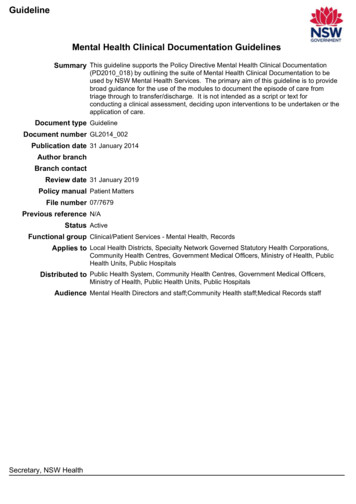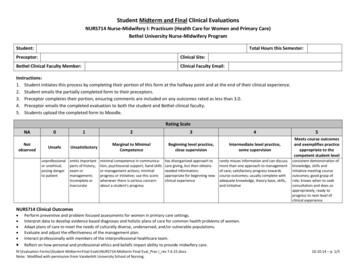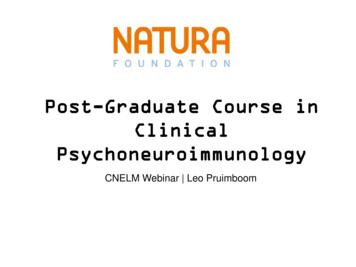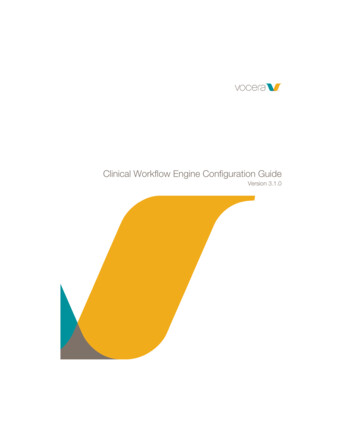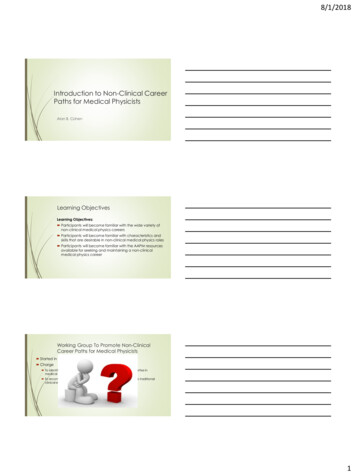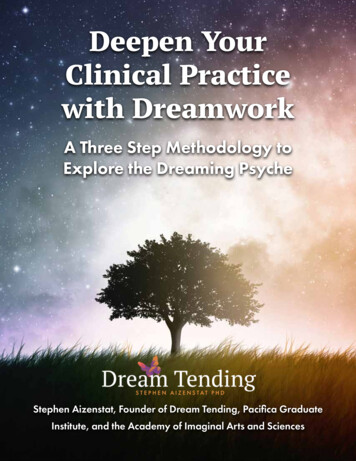
Transcription
Deepen YourClinical Practicewith DreamworkA Three Step Methodology toExplore the Dreaming PsycheStephen Aizenstat, Founder of Dream Tending, Pacifica GraduateInstitute, and the Academy of Imaginal Arts and Sciences
“I believe that the DNA of our individual and planetary evolution is codedin the images of dreams. Combine this conviction with the idea that dreamimages not only live within us, they also exist all around us, in every animal,plant, and landscape of this world. Our dream images give meaning to ourpersonal and collective life’s story—the journey of who we are and who weare becoming.—Stephen AizenstatHello there,Since the beginning of the pandemic, there has been a nearly 40% increase in nightmares.A national survey conducted by the American Academy of Sleep Medicine (AASM) reveals thatalmost 60% of Americans are now experiencing psychologically related insomnia. This has resultedin a large increase in the usage of antidepressant and sleep-aid prescription drugs.When your clients bring you their dreams, what approach do you offer? Do youinterpret them? Although there is nothing wrong with interpreting dreams, DreamTending differs significantly in its approach.During my career as a depth and clinical psychologist, marriage and familytherapist, and founder of Pacifica Graduate Institute, I have tended the dreams ofthousands of people around the world. From my time in the field, I have crafted athree-step methodology of working with a dream that I find particularly generative.As this has been my life’s work for the past 40 years, I am honored to offer youthis short guidebook to help you work with your clients’ crippling anxiety, isolatingdepression, and emotional/psychological upheaval in these times of uncertainty.The guide that follows opens with a description of Dream Tending written by apast colleague of mine, clinical psychologist Larry Brooks. From there, you will findmy original work in the order of association, amplification, and animation. Thismethodology of working with dreams is the praxis of Dream Tending.I truly hope this practice aids you and your clients.In the dreamtime,Stephen Aizenstat1
Stephen AizenstatStephen Aizenstat, Ph.D., is the founder of Dream Tending, PacificaGraduate Institute, and the Academy of Imaginal Arts and Sciences.He is a world-renowned professor of depth psychology, an imagination specialist, and an innovator. He has served as an organizationalconsultant to major companies, institutions, and as a depth psychological content advisor to Hollywood film makers. Dr. Aizenstat haslectured extensively in the U.S., Asia, and Europe. He is affiliated withthe Earth Charter International project through the United Nations,where he has spoken. He has collaborated with many notable mastersin the field including Joseph Campbell, James Hillman, Marion Woodman, and Robert Johnson.What is Dream Tending?Dream Tending is a comprehensive dreamwork methodologythat offers ways of accessing the healing powers of dreams.This approach views the dreaming psyche as multidimensional.Dreams are perceived as portals, opening the doors to thepersonal, collective, and universal realms of consciousness.Dream Tending is different from dream interpretation. To tenda dream is to experience the figures in dreams as embodied,with imaginal substance and pulse. As dreams are animated,it becomes possible to experience their intelligence and listento their stories. These teachings inform our life purpose andrespond to what the world is asking of us now.Benefits of Dream TendingIncrease Your AwarenessLearn how to befriend dream figures ascompanions of the soul.Expand Your ConsciousnessDiscover a shift in consciousness andexperience liberation.Discover Your PotentialMove from the confines of your fearsto a realm of creativity.2
To Interpret a Dream or to Tend to a Dream?By Larry Brooks, Ph.D.What Is Dream Interpretation?Freud’s work is foundational to dream interpretation. The publication of his seminal book The Interpretation of Dreams in 1900initiated a seismic cultural shift in understanding psychological phenomena and recognizing the importance of dreams. The key wordin the title and the central principle of his book is interpretation. The dream is viewed as a riddle emanating from the individual’sunconscious, holding a hidden meaning that needs to be deciphered. The knowledge and expertise of the dream analyst aregrounded in a theoretical framework that directs the interpretive action of dreamwork. While much has changed since the time ofFreud, the role of interpretation is still the predominant tool in dreamwork.What Is Dream Tending?Dream Tending is a way of working with dreams developed by Stephen Aizenstat. While it builds on the work of Freud and Jung, itis much more than a methodology. Influenced by James Hillman, founder of archetypal psychology, two qualities distinguish DreamTending from dream interpretation—first, how it views the dream tender, and second, how it views the dream image. The term dreamtending was intentionally chosen to emphasize a relationship to the dream characterized by caring and open-mindedness. Thissensibility, grounded in a spirit of not-knowing, distinguishes Dream Tending from dream interpretation in which the psychotherapistoccupies a position of authority by virtue of their expertise.How Does Dream Tending Conceptualize Dreams?Aizenstat views the dream image not merely as a symbol that has meaning, but as a “living image,” in the words of James Hillman, or as“persons of the soul.” Night after night, the dreaming psyche receives these images from a source greater than the individual. Aizenstatstates, “Dream images are not representations of our personal nature only, but are also informed by the subjective inner natures ofthe things and creatures in the world. The imaginal field beyond the inter-subjective is the extra-subjective that I am equating with theautonomy of the image.”The Art of Dream TendingSince dreams are not the product of a logical mind, you need to bypass the rational ego to access their deeper significance. To theextent that you interpret a dream, you are limited by the parameters of an interpretive system. In contrast to dream interpretation, inDream Tending the ego is seen as an obstacle. It will prematurely foreclose inquiry and too quickly try to make sense of the dream.Hillman states, “Dreams call from the imagination to the imagination and can be answered only by the imagination.” The dream imageis like a boat moored to a dock. The image reveals itself and individuates when it is unmoored and allowed to drift.Rather than interpret a dream, the dream tender animates the image. Animation is the heart and soul of Dream Tending. It isquintessentially improvisation, a playing with images guided by an attentiveness to affect and the nuances of the dream, along with anoverarching curiosity and vigilance to the ever-present intrusive presence of ego.The dream tender meets the dream with curiosity as if a tourist in a foreign country, gathers associations, and asks the dreamer whatparts of the dream generate curiosity, attraction, fright, or repulsion. The answers to these questions lead to finding an emotionallyresonant image with which to work. When the image is identified, the dreamer is asked to imagine the image in the room in order tointeract with it. The dream tender is attentive to how the dreamer is telling the dream with words and gestures, and how the dreamerexperiences the dream in the present.Dreams, on occasion, evoke strong feelings in individuals, such as fear, repulsion, and shame. The dream tender helps the dreamertolerate these difficult feelings and facilitates curiosity about the images in order to understand their deeper nature. As the dreamermoves through fear and repugnance to a relationship with the image, the image evolves, and something of value can be learned.From a blog post by Larry Brooks, PhD. References: Blake, A. https://www.youtube.com/watch?v 9eyZSvfShKo; Freud, S., The Interpretation of Dreams, Tr. by James Strachey,Standard Edition of the Complete Works of Sigmund Freud, Vol IV & V, Hogarth Press, 1953. Hillman, J., Archetypal Psychology: A Brief Account, Spring Publications, 1983.3
Dream Tending MethodologyI. AssociationMethods of AssociationAssociation or associative methods are those that link dream images to similar life events or circumstances. They are used to expandthe dream, making connections to present or past life circumstances of the dreamer. These methods are used by the dream tenderin the exploratory phases of dream interpretation, helping to create a context of circumstances, emotions, and events to which thedream offers insight and provides meaning.A. Associate to Dream Elements.1. Proceed chronologically through the dream, having the dreamer associate with the individual consecutive elements. In thisway the dream becomes understood in the context of a more complete background. The dream becomes one part of thedreamer’s current totality of life experience—the full picture.2. Focus on one particular element of the dream. The dream tender can then go into considerable associative depth with aparticular dream image, choosing to start with the most compelling element or the most (seemingly) innocuous image in thedream.3. Replace an either/or uncertainty of dream content with a both/and. Take each of the apparent alternatives as anindependent starting point for a series of associations, thereby opening both sides of the polarity. For example, the dreamof a man in women’s clothes would invite associations to aspects of the dreamer’s experience of both the masculine and thefeminine.B. Associate to Metaphors and/or Puns in The Dream.1. Identify metaphors in a dream and associate them to their possible meaning. Here are five common dream themes that maybe viewed as metaphors and worked with in an associative fashion.a. Dreams of nudity may be associated with honesty, openness, vulnerability, etc.b. Dreams of flying may be associated with being “high,” “on top of the world,” etc.c. Dreams of falling may be associated with “falling out of favor,” “falling from esteem,” “falling from grace,” etc.d. Dreams of finding money may be associated with discovering new riches, finding that which is of value, etc.e. Dreams of examination may be associated with being “under examination” or being tested, etc.The dream tender may notice other metaphorical themes that reoccur in the dreams of individual dreamers over time.2. Identify puns in a dream and associate them to their possible meanings. Here are six ways of working with the pun in anassociative fashion:a. Dreams based on verbal puns in which one word represents another of similar pronunciation but different spelling—for example, a dream of men being dressed in gilt to express a feeling of their being steeped in guilt.b. Dreams based on reversal puns—for example, a dream of filling full a jar, which expresses a sense of being fulfilled.c. Dreams based on visual puns in which the dream creates a picture based on one sense of a word—for example, adream of a baseball game to reflect a feeling of being involved in a base, underhanded game.d. Dreams based on puns involving proper names—as when a dream of a man in long johns represents radio host LongJohn Nebel.e. Dreams that create a literal picture of some colloquial or slang metaphor—for example, when a dream depicts aman “shooting me down” to express my fear of being attacked verbally, and a canceled cricket match to express myfeeling that something is “not cricket.”f.Dreams that create a literal picture of common body language—for example, a dream of a bare chest to depicta feeling of “getting something off one’s chest” and a dream of a one-armed man to reflect a feeling of being“disarmed.”4
C. Associate to Events, Moods, Characters, or Places in the Dream.1. Associate to the events in a dream. The dream tender may find connections to the preceding day’s events or significantpersonal historical events by having the dreamer associate with dream events.2. Associate to the mood in a dream. The dream tender may find connections to past familiar feelings or moods by having thedreamer associate to the mood experienced while in the dream.3. Associate to the places in the dream. The dream tender may find connections to familiar places in awake-life from theassociations the dreamer has to places appearing in the dream.4. Associate to the characters in the dream. The dream tender may find connections to people in the dreamer’s life from theassociations the dreamer has to people in the dream.II. AmplificationMethods of AmplificationAmplification or methods of amplification are used by the dream tender to deepen the dream imagery, to enhance it, and to makeconnection with its archetypal references. Amplification is usually done in the information phase of dream actualization, although thisprocess is also effective as the final step in the dreamwork.An important distinction is to be made between personal developmental methods of association and archetypal methods ofamplification. Personal developmental methods of association link dream images to similar life events, circumstances, and symbols.Archetypal methods of amplification stay with one symbol, discovering its essential characteristics and plunging into its core. Aparticularly important form of amplification is that of dramatization. Methods of dramatization are those that actualize the archetypaldream images, symbols, and patterns through various kinds of creative expression.A. Research Dream Symbols for Enhanced Meaning.1. Investigate religion, myths, fairy tales, and so forth for themes related to dream symbols. Identical motifs occurring inawake-life and reflected in dream-life may be age-old human situations and reflected in myth. These mythic, archetypalreferences often provide important perspectives and guidance about the meanings of the dream symbol.2. Investigate dream figures and themes for cultural analogies. The dream tender uses the techniques of “like” or “as” toidentify similarities to cultural or mythical figures or themes.3. Employ etymological references. Etymology—the study of the origins of words—is an effective tool for penetratingfundamental concepts. In dreamwork, the use of etymological references is a particularly efficacious method of amplifyingthe dream image by tracing it back to its root origins.B. Determine the Major Dream Symbols’ Most Essential Characteristics1. Associate around major dream symbols to establish core meanings. Establishing a network of connections, the dreamtender allows for essential characteristics to emerge, become amplified, and present themselves as basic themes.2. Identify the symbol’s archetypal base. This is a process of reductive amplification. The dream tender guides the dreamer in aprocess of reducing the symbol to its most essential characteristics in order to identify the archetype underlying it.C. Express the Dream in Poetry and/or Story.1. Use the dream as a creative source for stories and poems. The dream tender may gain additional insight into the dreamafter the dreamer enlarges it, or amplifies it, into a new form such as a story or a poem.2. Translate the dream into a folktale. The traditional folktale structure offers a way of using a culturally evolved pattern for thepurposes of amplifying dream material.3. Translate the dream into a parable. A dream may seem to appear as a teaching story or parable designed to illustrate alesson. The dream tender may suggest that the dream be amplified (re-experienced and re-written) as a parable offeringguidance for awake-life activity.5
D. Express the Dream in Music and Dance.1. Move through the sequences of a dream expressing the feelings and actions of the dream. The dream tender may assistthe dreamer in finding appropriate music that helps capture the mood of the dream and allows for fuller expression by thedreamer. Amplifications through body movement often evoke elemental, archetypal forms and gestures.2. Actualize the archetypal patterns of the dream through dance. The dream tender suggests the dreamer dance the dream.Many times certain primal scenes or patterns will emerge from the dance. The following questions facilitate amplifications:a. What are the primal gestures and scenes?b. Are they expressive of your total personality or only a part?c. How can you dance the dream to resolution?d. What meditation, sharing, or journal work is needed to bring the experience to consciousness?e. If you are a rational person (a thinker), how can you dance your dream to get your body to use its archetypalenergies more fully?3. Translate the dream images into music. By actualizing dream images with music, the dreamer can experience theelemental pulse of the dream-the basic rhythm. This, in-and-of-itself, can illuminate the archetype being expressed.E. Express the Dream in Mythic Drama and Ritual Form.1. Enact the dream as a dramatic presentation. In a group setting, various people may be asked to “play” differentcharacters in the dream and reenact it as a dramatic presentation. This method often has a powerful emotional andpsychological impact on the dreamer and the drama participants. Care and skilled leadership is required from the dreamtender to ensure a constructive, healing experience.2. Design a ritual to amplify or actualize. Rituals are one of the oldest and most powerful forms of the healing arts. They can beused in dreamwork as a method of evoking and transforming the archetypal dimensions of a dream. Sometimes, there will beritual acts illustrated right in the dream itself, which the dream tender may help amplify into enactment. The dream tender mustbe knowledgeable in the craft of ritual in order to provide caring leadership and safety.F. Express the Dream Through Art.1. Give dream images tangible form through painting, drawing, and clay sculpture. For many people, it is easier to relateto dream images expressed in some tangible form. The dream tender may suggest a method of artistic amplification thatincludes a dialogue between the dreamer and the objects that are created2. Actualize dream paintings or sculptures in a creative context. The dream tender may suggest to the dreamer thatamplificatory artwork be developed in one of the following ways:a. Draw, paint, or sculpt contrasting symbols in dreams.b. Cluster dream symbols and paint them as a mandala.c. Be aware of central healing figures and symbols.d. Keep a journal of dream drawings.III. AnimationMethods of AnimationAnimation or Dream Tending methods of animation are based on the idea that dream images are alive. Methods of animation returnto the vitality that is inherent in the dream image. Dream Tending methods of animation are used to “re-animate” or “resuscitate”6dream images, that is, to bring back to life images that have otherwise been reduced to the medium of narrative or description.
Unlike the personal developmental methods of association that link dream images to similar life events, or archetypal methods ofamplification that enhance dream images through investigating similar symbolic references, the “ecological” methods of animationfocus on the actuality of the image.These methods explore the dream image as a living phenomenon in and of itself. Dream images are experienced as active,embodied, imaginal entities, with presence and pulse. Information about the dream is generated, therefore, not through aninterpretive method of image-linking, nor through an analytical process of image enhancement, but through an animating process ofembodied correspondence among the dreamer, dream tender, and dream image. For example, an elephant appears in a dream. Inaddition to considering the dream elephant from the personalistic point of view (elephant as representing my animal instinct) or fromthe perspective of the collective (elephant representing a sacred animal or deity), the emphasis here is on the living, breathing activityof the elephant as a “living image” of the dream. Methods of animation are used to enliven the field of consciousness that existsbetween dreamer and dream image so that the embodied presence of the image can be experienced as alive.A. Tend Dream Images in a Manner that Regards Their Existence as Imaginal Beings—as HavingBody, Presence, and Pulse.1. First, listen deeply into the movements of your own psychic nature. Then, bring this quality of mindfulness into relationshipwith the dream. Engage the dream from the depth of your nature, evoking the deeper natures of dream images.2. Tend the dream in silence, noticing the activity of the dream images in relation to each other and in relation to you. Donothing. Ask nothing. While “tending silence,” stay in the immediacy of the experience—be present in the “here and now”activity of the dream.3. Again, come back into yourself and listen to your own heart, to the pulse that moves through you in the immediacy of yourpresent experience. Now, return to the dream and select an individual figure and follow it around. Watch its activity, staywith it. Write down feelings, associations, and imaginings you are having as a result of being affected by the figure. Takecare not to explain or analyze the figure from your “reasoned” perspective. Repeat this exercise with a “less obvious”figure.B. Use Tools of Animation to Bring the “Breath of Life” to the Dream.1. Attend to breathing. Pay attention to your own breathing and bring yourself into a mindful state of being, into your ownresonant nature. Now, mindfully enter the dreamscape and patiently watch an image. Notice the activity as it “comes tolife.”2. Become co-respondent with the dream image. Once active, the image body will move about on its own behalf. Followits motion and attune to its “cadence” or “breath.” Become sympathetic to its sense of self, its sound or pulse. In otherwords, become co-respondent with it, according to its nature.3. Resonate with the harmonic of the dream image body. Each image, as image body, is a medicine of the soul. As amedicine, the image body affects our physical body in a resonant way. We experience the affective quality of an image asa felt sense. Attend to the harmonic that is created when a dream image is animated as image body.4. Notice how we are affected in non-causal ways by the correspondence between the physical body and dream imagebodies.C. Tend the Dream as a Living Event Situated between Dreamer and Dream Tender.1. Experience the dream image as existing between the dreamer and the dream tender, as if “hosting” the dream as “guest.”Engage the dream as if it is a living reality, in the room along with you. Invite the presentation of the “other bodies”—theshades, the ghosts, and the mythic people of the dreamtime.2. Take the articles—a, an, the—out of the dream. This practice returns body to image. For example, tell the dream as “snakeslithered” rather than “the snake slithered.”3. Make physical allowance for the presence of the “third body.” Angle your chairs slightly away from a face-to-facearrangement. This configuration, as opposed to sitting directly across from one another, allows the necessary space for thedream images to be present in the room. It is as if the dreamer and the dream tender become part of the dreamscape that isoccurring between them, rather than the dreamscape being imagined as located exclusively inside the dreamer’s head. 7
D. Witness Dream Images in the Particularity of Their Appearance.1. Notice the particularity of dream images as they become increasingly visible and distinct. Look for specificity of color,texture, detail of facial features, and so on. To particularize is to recognize the unique characteristics of the dream imageand thus to bring life to the image.2. Make a distinction between a general category of dream figures such as “snakes” and the particular dream image “snake”that is occurring in this specific dream. For example, is the snake of this dream a rattlesnake or a cobra? And, even moreimportant, what distinguishes this rattler or cobra from another?E. Use Your Senses to Experience Dream Images as Embodied Presences.1. Use your senses of hearing, smelling, and touching to experience dream images as embodied. To smell, hear, or touchan image is to bring a quality of physical contact to an image. Using the senses to experience imaginal figures brings thedreamer into an “embodied” relationship with the dream image. Sensate contact connects the dreamer with the living image,recognizing that dream images have presence and body. For example, the smell of the dream ocean, the sound of the dreamcrow, or the texture of the dream dress brings with it an experience of an image with imaginal body.2. When looking at dream images imaginally, view them with “soft eyes” and with “focused eyes.” Soft eyes is a style of seeingin which the dreamer looks with relaxed, “peripheral eyes,” taking in the wide scope of activity. Focused eyes is a style inwhich the dreamer narrows their vision to see particularity. In both cases, the dreamer looks at dream images as if they werein the room. There is a sense of seeing the invisibles as visible. Using soft and focused eyes provides the dreamer with styles ofseeing that allow the dream image to be viewed as an imaginal presence with image body.3. Listen responsively to any sound that is present in the dream. To listen responsively is to hear into a dream image—to takethe time to listen to the sound that is being generated from deep inside the image. It is as if the dreamer waits and listens forechoes, responsive to the sound that resonates from the essential nature of a dream figure.Dream Tending and Imagination ProgramsDo you want to ignite your creativity and have a greater understanding of the human experience? Doyou want to help your clients find their life purpose, tend their nightmares, and befriend frighteningreoccurring dream images? Do you long to be part of an extended community of like-minded psychotherapists and people in the healing professions who are called to the value of imagination anddreams?Join us for an upcoming program Dream Tending and Imagination Workshop The Imagination Matrix: The Journey Continues Dream Tending Master Class Dream Tending Retreats Clinician and Helping Professions Workshops Dream Tending and Deep Imagination Certificate I Dream Tending and Deep Imagination Certificate II Dream Tending and Deep Imagination Certificate III To find out more go to www.dreamtending.comPlease visitdreamtending.comfor programinformation, dates,registrationsdetails, and more.8
DREAMTENDING.COM
Dream Tending is a comprehensive dreamwork methodology that offers ways of accessing the healing powers of dreams. This approach views the dreaming psyche as multidimensional. Dreams are perceived as portals, opening the doors to the personal, collective, and universal realms of consciousness. Dream Tending
